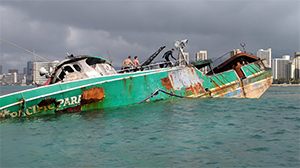After a two-month salvage that cost more than $1 million, crews overseen by the U.S. Coast Guard removed a longline fishing vessel from a coral reef about 500 yards off Oahu’s busy Kaimana Beach.
The salvors leveraged a foam application technique commonly used in the rocky waters surrounding Alaska to refloat the 79-foot Pacific Paradise on Dec. 7. The U.S.-flagged vessel, owned by TWOL LLC of Honolulu, grounded on Oct. 10 after striking a high spot on the reef.
Challenging surf conditions and shallow water made the salvage difficult and lengthy. The location of the wreck also prompted environmental concerns due to nearby swimmers and the surrounding ecosystem, which includes an endangered population of monk seals.
On Oct. 14, a fire started on deck while the salvage team was dewatering the vessel. According to Coast Guard Chief Petty Officer Sara Muir, about 150 gallons of diesel fuel leaked into the ocean during the fire. The boat was carrying about 8,000 gallons of diesel and 55 gallons of lube and hydraulic oil when it grounded.
“There was light sheening seen a couple of times during the process, but it did break up and dissipate very quickly,” Muir said. “By and large, a majority of the fuel was removed.”
The fire burned for almost two days. During the following weeks, the resulting damage and high surf periodically stalled the salvage effort.
“That’s when Resolve (Marine Group) was brought in and awarded the project,” said David DeVilbiss of Global Diving & Salvage, who was hired by the Coast Guard as a third-party evaluator after the fire.
On Nov. 8, four days after drafting a proposal, Florida-based Resolve began putting its plan into action. Within two weeks, Resolve and its subcontractors, including American Marine and Cates International, obtained measurements of the vessel and removed several heavy steel sheets via helicopter.
 |
|
A responder welds a steel patch on the vessel to improve the integrity of its compromised hull prior to refloating. |
|
Courtesy U.S. Coast Guard |
“The area we were working in was way too shallow to bring a crane barge or anything else with significant lifting capacity,” said Todd Duke, a project manager at Resolve.
To help the vessel refloat over the high reef outcroppings, Resolve designed its salvage plan around filling the engine room with closed-cell foam. The technique displaces water and provides a significant amount of buoyancy, Duke said.
Salvors pumped foam down into the engine room through custom-made plastic bags designed to fit the dimensions of the space. As the foam expanded to fill the room, it pushed water through several 4-inch and 6-inch hoses installed by divers. The hoses then discharged the water over the side of the vessel.
Due to suspected damage to the bottom of the hull, the closed-cell foam application seemed like the most appropriate solution, Duke said.
“Bottom damage in an engineering space is almost impossible to repair,” he said. “You’re not going to put a wooden patch on something like this, because you know it’s just not going to hold once you try and refloat the vessel.”
The foam application displaced about 125 tons of water and prepared Pacific Paradise for the last stage of the salvage. But uncharacteristically calm surf conditions ended up pushing the removal effort back by a day.
“We were actually counting on a little bit of surf to help get the vessel over some of the high spots (on the reef),” Duke said.
On Dec. 7, tugboats from American Marine and Foss Maritime maneuvered Pacific Paradise off the reef and into a natural channel after several unsuccessful attempts. The longliner was towed 13 miles offshore and sunk at a federally approved disposal site, Muir said.
“I think the job was done professionally, with care to the environment being the primary focus. It was also done safely,” DeVilbiss said. No significant injuries were reported during the grounding or the salvage.

